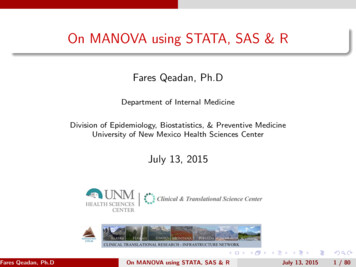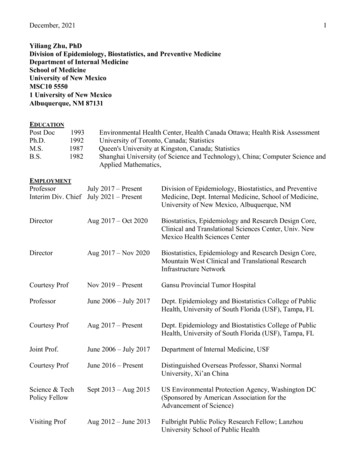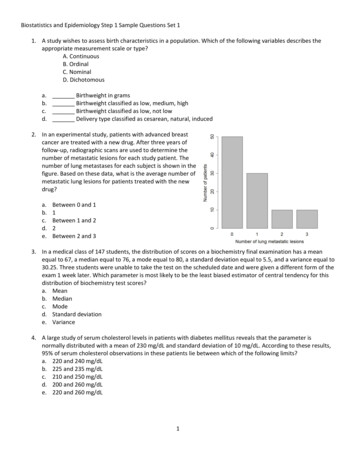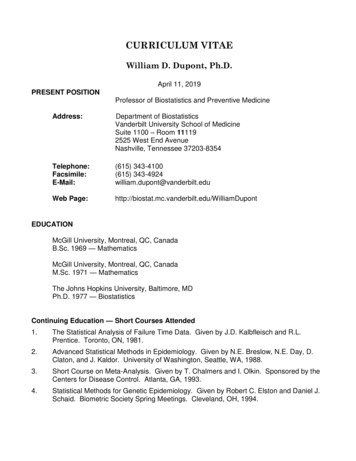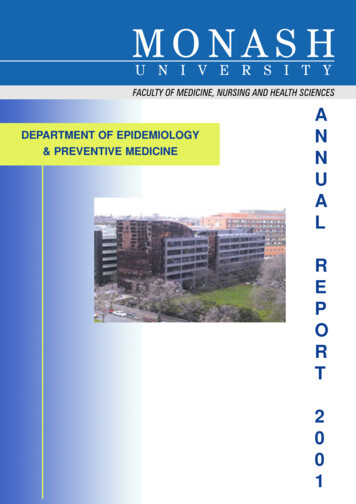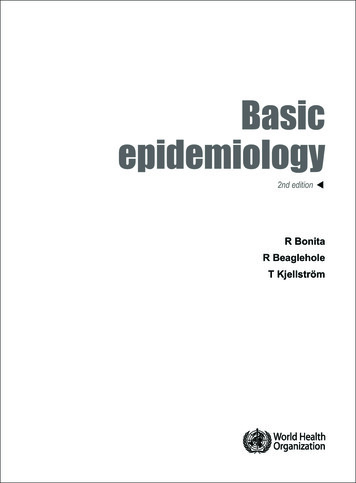
Transcription
2nd edition BasicepidemiologyR BonitaR BeagleholeT Kjellström
WHO Library Cataloguing-in-Publication DataBonita, Ruth.Basic epidemiology / R. Bonita, R. Beaglehole, T. Kjellström. 2nd edition.1.Epidemiology. 2.Manuals. I.Beaglehole, Robert. II.Kjellström, Tord. III.World Health Organization.ISBN 92 4 154707 3ISBN 978 92 4 154707 9(NLM classification: WA 105) World Health Organization 2006All rights reserved. Publications of the World Health Organization can be obtained from WHO Press,World Health Organization, 20 Avenue Appia, 1211 Geneva 27, Switzerland (tel.: 41 22 791 2476;fax: 41 22 791 4857; e-mail: bookorders@who.int). Requests for permission to reproduce or translateWHO publications – whether for sale or for noncommercial distribution – should be addressed to WHOPress at the above address (fax: 41 22 791 4806; e-mail: permissions@who.int).The designations employed and the presentation of the material in this publication do not imply theexpression of any opinion whatsoever on the part of the World Health Organization concerning the legalstatus of any country, territory, city or area or of its authorities, or concerning the delimitation of its frontiersor boundaries. Dotted lines on maps represent approximate border lines for which there may not yet befull agreement.The mention of specific companies or of certain manufacturers’ products does not imply that they areendorsed or recommended by the World Health Organization in preference to others of a similar naturethat are not mentioned. Errors and omissions excepted, the names of proprietary products are distinguishedby initial capital letters.All reasonable precautions have been taken by the World Health Organization to verify the informationcontained in this publication. However, the published material is being distributed without warranty ofany kind, either expressed or implied. The responsibility for the interpretation and use of the material lieswith the reader. In no event shall the World Health Organization be liable for damages arising from itsuse.The named authors alone are responsible for the views expressed in this publication.Printed in India.
ContentsContentsPrefaceixIntroductionxiChapter 1 What is epidemiology?Key messagesThe historical contextOriginsRecent developments in epidemiologyDefinition, scope, and uses of epidemiologyDefinitionScopeEpidemiology and public healthCausation of diseaseNatural history of diseaseHealth status of populationsEvaluating interventionsAchievements in epidemiologySmallpoxMethyl mercury poisoningRheumatic fever and rheumatic heart diseaseIodine deficiency diseasesTobacco use, asbestos and lung cancerHip fracturesHIV/AIDSSARSStudy pter 2 Measuring health and diseaseKey messagesDefining health and diseaseDefinitionsDiagnostic criteriaMeasuring disease frequencyPopulation at riskIncidence and prevalenceCase fatalityInterrelationships of the different measuresUsing available information to measure health and diseaseMortalityLimitations of death certificatesLimitations of vital registration systemsTowards comparable estimatesDeath ratesInfant mortalityChild mortality rate151515151617171822222323232424252626iii
ivContentsMaternal mortality rateAdult mortality rateLife expectancyAge-standardized ratesMorbidityDisabilityHealth determinants, indicators, and risk factorsOther summary measures of population healthComparing disease occurrenceAbsolute comparisonsRelative comparisonsStudy er 3 Types of studiesKey messagesObservations and experimentsObservational studiesExperimental studiesObservational epidemiologyDescriptive studiesEcological studiesEcological fallacyCross-sectional studiesCase-control studiesCohort studiesSummary of epidemiological studiesExperimental epidemiologyRandomized controlled trialsField trialsCommunity trialsPotential errors in epidemiological studiesRandom errorSample sizeSystematic errorSelection biasMeasurement biasConfoundingThe control of confoundingValidityEthical issuesStudy 051515252535354555657586060Chapter 4 Basic biostatistics: concepts and toolsKey messagesSummarizing dataTables and graphsPie charts and component band chartsSpot maps and rate mapsBar charts63636364646565
ContentsLine graphsFrequency distributions and histogramsNormal distributionsSummary numbersMeans, medians and modeVariances, standard deviations and standard errorsBasic concepts of statistical inferenceUsing samples to understand populationsConfidence intervalsHypothesis tests, p-values, statistical powerThe p-valueStatistical powerBasic methodst-testsChi-squared tests for cross tabulationsCorrelationRegressionLinear regressionLogistic regressionSurvival analyses and Cox proportional hazards modelsKaplan-Meier survival curvesSample size issuesMeta-analysisStudy questionsReferencesChapter 5 Causation in epidemiologyKey messagesThe concept of causeSufficient or necessarySufficient and necessaryA causal pathwaySingle and multiple causesFactors in causationInteractionA hierarchy of causesEstablishing the cause of a diseaseConsidering causationTemporal response relationshipReversibilityStudy designJudging the evidenceStudy 3939595969697v
viContentsChapter 6 Epidemiology and prevention: chronic noncommunicablediseasesKey messagesThe scope of preventionRecent trends in death ratesPreventive potentialCausation frameworkLevels of preventionPrimordial preventionPrimary preventionPopulation strategyHigh-risk individual strategySecondary preventionTertiary preventionScreeningDefinitionTypes of screeningCriteria for screeningStudy 8109110110110110114114Chapter 7 Communicable diseases: epidemiology surveillance andresponseKey messagesIntroductionDefinitionsRole of epidemiologyThe burden of communicable diseaseThreats to human security and health systemsEpidemic and endemic diseaseEpidemicsEndemic diseasesEmerging and re-emerging infectionsChain of infectionThe infectious agentTransmissionHostEnvironmentInvestigation and control of epidemicsInvestigationIdentifying casesManagement and controlSurveillance and responseStudy 22123123124125125126126126126127130131Chapter 8 Clinical epidemiologyKey messagesIntroductionDefinitions of normality and abnormality133133133133
ContentsNormal as commonAbnormality associated with diseaseAbnormal as treatableDiagnostic testsValue of a testNatural history and prognosisPrognosisQuality of lifeQuantity of lifeEffectiveness of treatmentUse of evidence-based guidelinesPrevention in clinical practiceReducing risksReducing risks in patients with established diseaseStudy 40140141141142143145Chapter 9 Environmental and occupational epidemiologyKey messages145Environment and health145Impact of exposure to environmental factors146Evaluation of preventive measures147Exposure and dose149General concepts149Biological monitoring150Interpreting biological data151Individual versus group measurements151Population dose152Dose–effect relationships153Dose–response relationships154Assessing risk155Risk assessment155Health impact assessment155Risk management155Environmental health impact assessment155Injury epidemiology157Traffic crash injuries157Workplace injury157Violence158Suicides158Special features of environmental and occupational epidemiology 159Setting safety standards159Measuring past exposure160Healthy worker effect in occupational studies160Continuing challenges for epidemiologists160Study questions161References161Chapter 10 Epidemiology, health policy and planningKey messagesIntroduction165165165vii
viiiContentsHealth policyHealth planningEvaluationHealth policyThe influence of epidemiologyFraming health policyHealth policy in practiceHealth planningThe planning cycleAssessing burdenUnderstanding causesMeasuring effectiveness of interventionsAssessing efficiencyImplementing interventionsMonitoring activities and measuring progressStudy 72172173174175175176Chapter 11 First steps in practical epidemiologyKey messagesIntroductionSpecific diseasesCritical readingPlanning a research projectChoosing a projectWriting the protocolDoing the researchAnalysing the dataGetting publishedFurther readingFurther trainingStudy 3183183184185186187187AnnexAnswers to Study Questions189Index207
PrefacePrefaceBasic epidemiology was originally written with a view to strengthening education,training and research in the field of public health. Since the book was published in1993, more than 50 000 copies have been printed, and it has been translated intomore than 25 languages. A list of these languages and contact addresses of localpublishers is available on request from WHO Press, World Health Organization, 1211Geneva 27, Switzerland.Basic epidemiology starts with a definition of epidemiology, introduces the history of modern epidemiology, and provides examples of the uses and applications ofepidemiology. Measurement of exposure and disease are covered in Chapter 2 and asummary of the different types of study designs and their strengths and limitationsis provided in Chapter 3. An introduction to statistical methods in Chapter 4 sets thescene for understanding basic concepts and available tools for analysing data andevaluating the impact of interventions. A fundamental task of epidemiologists is tounderstand the process of making causal judgements, and this is covered in Chapter5. The applications of epidemiology to broad areas of public health are covered in thefollowing chapters: chronic noncommunicable disease (Chapter 6), communicabledisease (Chapter 7), clinical epidemiology (Chapter 8) and environmental, occupational and injury epidemiology (Chapter 9); the process of health planning is outlinedin Chapter 10. The final chapter, Chapter 11, introduces the steps that new epidemiologists can take to further their education and provides links to a number of currentcourses in epidemiology and public health.As with the first edition of Basic epidemiology, examples are drawn from differentcountries to illustrate various epidemiological concepts. These are by no means exhaustive or comprehensive and we encourage students and teachers to seek locallyrelevant examples. Each chapter starts with a few key messages and ends with a seriesof short questions (answers are provided) to stimulate discussion and review progress.The authors gratefully acknowledge contributions to the first edition fromJohn Last and Anthony McMichael. Martha Anker wrote Chapter 4 for the firstedition. In the second edition, Chapter 4 was written by Professor O. Dale Williams.A version of the course material upon which this chapter is based is available athttp://statcourse.dopm.uab.edu.In addition, the authors would like to thank the following people for their contributions to the second edition: Michael Baker, Diarmid Campbell-Lendrum, CarlosCorvalen, Bob Cummings, Tevfik Dorak, Olivier Dupperex, Fiona Gore, Alec Irwin,Rodney Jackson, Mary Kay Kindhauser, Doris Ma Fat, Colin Mathers, HoomenMomen, Neal Pearce, Rudolpho Saracci, Abha Saxena, Kate Strong, Kwok-Cho Tang,and Hanna Tolonen. Laragh Gollogly was managing editor, and graphic design wasdone by Sophie Guetanah-Aguettants and Christophe Grangier.The International Programme on Chemical Safety (a joint programme of theUnited Nations Environment Programme, the International Labour Organization, andthe World Health Organization), the Swedish International Development Authority(SIDA) and the Swedish Agency for Research Cooperation with Developing Countries(SAREC) all supported the original development of this book.ix
IntroductionIntroductionThe essential role of epidemiology is to improve the health of populations. This textbook provides an introduction to the basic principles and methods of epidemiology.It is intended for a wide audience, and to be used as training material for professionalsin the health and environment fields.The purpose of this book is to: explain the principles of disease causation with particular emphasis on modifiableenvironmental factors, including environmentally-determined behaviours, encourage the application of epidemiology to the prevention of disease and thepromotion of health, prepare members of the health-related professions for the need for health servicesto address all aspects of the health of populations, and to ensure that health resources are used to the best possible effect, and encourage good clinical practice by introducing the concepts of clinicalepidemiology.At the end of the course the student should be able to demonstrate knowledge of: the nature and uses of epidemiology the epidemiological approach to defining and measuring the occurrence of healthrelated states in populations the strengths and limitations of epidemiological study designs the epidemiological approach to causation the contribution of epidemiology to the prevention of disease, the promotion ofhealth and the development of health policy the contribution of epidemiology to good clinical practice and the role of epidemiology in evaluating the effectiveness and efficiency of healthcare.In addition, the student will be expected to have gained a variety of skills, includingan ability to: describe the common causes of death, disease and disability in her or hiscommunity outline appropriate study designs to answer specific questions concerning diseasecausation, natural history, prognosis, prevention, and the evaluation of therapyand other interventions to prevent and control disease.xi
1Chapter 1What is epidemiology?Key messages Epidemiology is a fundamental science of public health. Epidemiology has made major contributions to improving population health. Epidemiology is essential to the process of identifying and mapping emergingdiseases. There is often a frustrating delay between acquiring epidemiological evidenceand applying this evidence to health policy.The historical contextOriginsEpidemiology originates from Hippocrates’ observation more than 2000 years ago thatenvironmental factors influence the occurrence of disease. However, it was not untilthe nineteenth century that the distribution of disease in specific human populationgroups was measured to any large extent. This work marked not only the formalbeginnings of epidemiology but also some of its most spectacular achievements.1 Thefinding by John Snow (Box 1.1) that the risk of cholera in London was related to thedrinking of water supplied by a particular company provides a well-known example;the map (see Figure 4.1) highlights the clustering of cases. Snow’s epidemiologicalstudies were one aspect of a wide-ranging series of investigations that examinedrelated physical, chemical, biological, sociological and political processes.2Comparing rates of disease in subgroups of the human population became common practice in the late nineteenth and early twentieth centuries. This approach wasinitially applied to the control of communicable diseases (see Chapter 7), but provedto be useful way of linking environmental conditions or agents to specific diseases.In the second half of the twentieth century, these methods were applied to chronicnoncommunicable diseases such as heart disease and cancer, especially in middleand high-income countries.Recent developments in epidemiologyEpidemiology in its modern form is a relatively new discipline1 and uses quantitativemethods to study diseases in human populations, to inform prevention and controlefforts. For example, Richard Doll and Andrew Hill studied the relationship betweentobacco use and lung cancer, beginning in the 1950s.4 Their work was preceded byexperimental studies on the carcinogenicity of tobacco tars and by clinical observations linking tobacco use and other possible factors to lung cancer. By using longterm cohort studies, they were able to establish the association between smokingand lung cancer (Figure 1.1).
2Chapter 1Box 1.1. Early epidemiological observationJohn Snow located the home of each person who died from cholera in London during1848–49 and 1853–54, and noted an apparent association between the source of drinkingwater and the deaths.3 He compared cholera deaths in districts with different water supplies(Table 1.1) and showed that both the number of deaths and the rate of deaths were higheramong people supplied water by the Southwark company. On the basis of his meticulousresearch, Snow constructed a theory about the communication of infectious diseases andsuggested that cholera was spread by contaminated water. He was able to encourageimprovements in the water supply long before the discovery of the organism responsiblefor cholera; his research had a direct and far-reaching impact on public policy.Snow’s work reminds us that public health measures, such as the improvement ofwater supplies and sanitation, have made enormous contributions to the health of populations, and that in many cases since 1850, epidemiological studies have identified theappropriate measures to take. It is noteworthy, however, that outbreaks of cholera are stillfrequent among poor populations, especially in developing countries. In 2006, Angolareported 40 000 cholera cases and 1600 deaths; Sudan reported 13 852 cases resulting in516 deaths in the first few months of the year.The British doctors cohort has also shown a progressive decrease in death ratesamong non-smokers over subsequent decades. Male doctors born between 1900–1930 who smoked cigarettes died, on average, about 10 years younger than lifelongnon-smokers5 (Figure 1.2).Smoking is a particularly clear-cut case, but for mostdiseases, several factors contribute to causation. SomeTable 1.1. Deaths from cholera in districts of Londonfactors are essential for the development of a disease andsupplied by two water companies,3 8 July to 26August 1854some increase the risk of developing disease. New epidemiological methods were needed to analyse these relaWater supply PopulaCholeraCholerationships. In low- and middle-income countries wherecompanytion 1851 deaths (n)death rate(per 1000HIV/AIDS, tuberculosis and malaria are common causespopulation)of death, communicable disease epidemiology is of vitalSouthwark167 6548445.0importance. This branch of epidemiology has now19 133180.9Lambethbecome important in all countries with the emergence ofnew communicable diseases such as sudden acute respiratory syndrome (SARS), bovine spongiform encephalopathy (BSE), and pandemic influenza. Epidemiology has evolved considerablyover the past 50 years and the major challenge now is to explore and act upon thesocial determinants of health and disease, most of which lie outside the healthsector.6–8Definition, scope, and uses of epidemiologyDefinitionEpidemiology as defined by Last9 is “the study of the distribution and determinantsof health-related states or events in specified populations, and the application of thisstudy to the prevention and control of health problems” (see Box 1.2). Epidemiologists are concerned not only with death, illness and disability, but also with more
What is epidemiology?Figure 1.1. Death rates from lung cancer (per 1000) by number of cigarettessmoked,4 British male doctors, 1951–1961Annual lung cancer death rates per 10004.03.53.02.52.01.51.00.50.00.0102030Average number of cigarettes smoked per day40positive health states and, most importantly, with the means to improve health. Theterm “disease” encompasses all unfavourable health changes, including injuries andmental health.ScopeA focus of an epidemiological study is the population defined in geographical or otherterms; for example, a specific group of hospital patients or factory workers could bethe unit of study. A common population used in epidemiology is one selected froma specific area or country at a specific time. This forms the base for defining subgroupsFigure 1.2. Survival from age 35 for continuing cigarette smokers and lifelong nonsmokers among British male doctors born 1900–1930 with percentages alive at eachdecade5Percentage survival from age 35100Doctors born 1900–1930979194808181Non-smokers586059Cigarette smokers10 years4024262024040506070Age (years)80901003
4Chapter 1with respect to sex, age group or ethnicity. The structures of populations vary betweengeographical areas and time periods. Epidemiological analyses must take suchvariation into account.Box 1.2. Definition of epidemiology9The word “epidemiology” is derived from the Greek words: epi “upon”, demos “people” and logos “study”.This broad definition of epidemiology can be further elaborated as follows:TermExplanationStudyincludes: surveillance, observation, hypothesis testing, analytic researchand experiments.Distributionrefers to analysis of: times, persons, places and classes of people affected.Determinantsinclude factors that influence health: biological, chemical, physical, social,cultural, economic, genetic and behavioural.refer to: diseases, causes of death, behaviours such as use of tobacco,positive health states, reactions to preventive regimes and provision anduse of health services.Health-related states and eventsSpecified populationsinclude those with identifiable characteristics, such as occupational groups.Application to prevention and controlthe aims of public health—to promote, protect, and restore health.Epidemiology and public healthPublic health, broadly speaking, refers to collective actions to improve populationhealth.1 Epidemiology, one of the tools for improving public health, is used in severalways (Figures 1.3–1.6). Early studies in epidemiology were concerned with the causes(etiology) of communicable diseases, and such work continues to be essential sinceit can lead to the identification of preventive methods. In this sense, epidemiology isa basic medical science with the goal of improving the health of populations, andespecially the health of the disadvantaged.Causation of diseaseFigure 1.3. CausationGenetic factorsGood healthEnvironmental factors(including behaviours)Although some diseases are caused solely by genetic factors, most result from aninteraction between genetic and environmental factors. Diabetes, for example, hasboth genetic and environmental components. We define environment broadly toinclude any biological, chemical, physical, psychological, economic or cultural factorsthat can affect health (see Chapter 9). Personal behavioursaffect this interplay, and epidemiology is used to studytheir influence and the effects of preventive interventionsthrough health promotion (Figure 1.3).Poor healthNatural history of diseaseEpidemiology is also concerned with the course and outcome (natural history) of diseases in individuals andgroups (Figure 1.4).
What is epidemiology?Figure 1.4. Natural historyDeathGood lth status of populationsEpidemiology is often used to describe the health status of population groups(Figure 1.5). Knowledge of the disease burden in populations is essential for healthauthorities, who seek to use limited resources to the best possible effect by identifyingpriority health programmes for prevention and care. In some specialist areas, such asenvironmental and occupational epidemiology, the emphasis is on studies of populations with particular types of environmental exposure.Figure 1.5. Describing the health status of populationsGood healthProportion with ill health,change over time,and with ageIllhealthTimeEvaluating interventionsArchie Cochrane convinced epidemiologists to evaluate the effectiveness and efficiency of health services (Figure 1.6).11 This means determining things such as theappropriate length of stay in hospital for specific conditions, the value of treating highblood pressure, the efficiency of sanitation measures to control diarrhoeal diseasesand the impact of reducing lead additives in petrol (see Chapter 10).Figure 1.6. Evaluating interventionsTreatmentMedical careGood healthIll healthHealth promotionPreventive measuresPublic health services5
6Chapter 1Applying epidemiological principles and methods to problems encountered inthe practice of medicine has led to the development of clinical epidemiology(see Chapter 8). Similarly, epidemiology has expanded into other fields such as pharmacoepidemiology, molecular epidemiology, and genetic epidemiology (Box 1.3).10Box 1.3. Molecular and genetic epidemiologyMolecular epidemiology measures exposure to specific substances and early biologicalresponse, by: evaluating host characteristics mediating response to external agents, and using biochemical markers of a specific effect to refine disease categories.Genetic epidemiology deals with the etiology, distribution, and control of disease in groupsof relatives, and with inherited causes of disease in populations.Genetic epidemiological research in family or population studies aims to establish: a genetic component to the disorder, the relative size of that genetic effect in relation to other sources of variation in diseaserisk, and the responsible gene(s).Public health genetics include: population screening programs, organizing and evaluating services for patients with genetic disorders, and the impact of genetics on medical practice.Achievements in epidemiologySmallpoxThe elimination of smallpox contributed greatly to the health and well-being of millions of people, particularly in many of the poorest populations. Smallpox illustratesboth the achievements and frustrations of modern public health. In the 1790s it wasshown that cowpox infection conferred protection against the smallpox virus, yet ittook almost 200 years for the benefits of this discovery to be accepted and appliedthroughout the world.An intensive campaign to eliminate smallpox was coordinated over many yearsby the World Health Organization (WHO). An understanding of the epidemiologyof smallpox was central to its eradication, in particular, by: providing information about the distribution of cases and the model, mechanisms and levels of transmission; mapping outbreaks of the disease; evaluating control measures (Box 1.4).The fact that there was no animal host was of critical importance together with thelow average number of secondary cases infected by a primary case.
What is epidemiology?7When a ten-year eradication programme was proBox 1.4. Epidemiological features of smallpox12posed by WHO in 1967, 10–15 million new cases and 2Epidemiological methods were used to establish the folmillion deaths were occurring annually in 31 countries.lowing features of smallpox:The number of countries reporting cases decreased rapidly there are no non-human hosts,in the period 1967–76; by 1976 smallpox was reported there are no subclinical carriers,from only two countries, and the last naturally-occurring recovered patients are immune and cannot transcase of smallpox was reported in 1977 in a woman whomit the infection,had been exposed to the virus in a laboratory. Smallpox naturally-occurring smallpox does not spread aswas declared to be eradicated on 8 May 1980.13rapidly as other infectious diseases such asmeasles or pertussis,Several factors contributed to the success of the pro transmission is generally via long-lasting humangramme: universal political commitment, a definite goal,to-human contact, anda precise timetable, well-trained staff and a flexible strat most patients are bedridden when they becomeegy. Furthermore, the disease had many features that madeinfectious, which limits transmission.its elimination possible and an effective heat-stable vaccine was available. In 1979, WHO maintained a stockpileof smallpox vaccines sufficient to vaccinate 200 millionpeople. This stockpile was subsequently reduced to 2.5 million doses, but givenrenewed concern about smallpox being used as a biological weapon, WHO continuesto maintain and ensure adequate vaccine stocks.14Methyl mercury poisoningMercury was known to be a hazardous substance in theMiddle Ages, but has recently become a symbol of thedangers of environmental pollution. In the 1950s, mercurycompounds were released with the water discharged froma factory in Minamata, Japan, into a small bay (Box 1.5).This led to the accumulation of methyl mercury in fish,causing severe poisoning in people who ate them.15This was the first known outbreak of methyl mercurypoisoning involving fish, and it took several years of research before the exact cause was identified. Minamatadisease has become one of the best-documented environmental diseases. A second outbreak occurred in the 1960sin another part of Japan. Less severe poisoning frommethyl mercury in fish has since been reported fromseveral other countries.15, 16Box 1.5. Minamata diseaseEpidemiology played a crucial role in identifying thecause and in the control of what was one of the firstreported epidemics of disease caused by environmentalpollution. The first cases were thought to be infectiousmeningitis. However, it was observed that 121 patientswith the disease mostly resided close to Minamata Bay.A survey of affected and unaffected people showed thatthe victims were almost exclusively members of familieswhose main occupation was fishing and whose dietconsisted mainly of fish. On the other hand, people visiting these families and family members who ate smallamounts of fish did not suffer from the disease. It wastherefore concluded that something in the fish hadcaused the poisoning and that the disease was not communicable or genetically determined.15Rheumatic fever and rheumatic heart diseaseRheumatic fever and rheumatic heart di
courses in epidemiology and public health. in Chapter 10. The final chapter, Chapter 11, introduces the steps th at new epidemi-John Last and Anthony McMichael. Martha Anker wrote the Chapt
